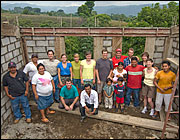Building houses, strengthening a church
Service trips to Nicaragua help revitalize Wisconsin church.
A Unitarian Universalist church in Wisconsin has sent almost 100 people to build houses in Nicaragua over the past seven years.* Members of the Unitarian Universalist Church West in Brookfield, Wisc., say the weeklong service trips have broadened their horizons, deepened the bonds between members, and helped revitalize their congregation.
The Brookfield congregation made its first trip to Nicaragua with the Bridges to Community humanitarian organization in 2004, and since then, has made a total of six trips, scheduling them every other year. A seventh trip, which will be the congregation's third this summer, is planned for August. According to Jim Fischer, who co-led the most recent trip, in July 2010, one third of those who have gone are return participants. “[The program's] growth has been explosive,” he said.
The Rev. Suzelle Lynch, the congregation’s minister, said, “Almost 100 people have gone since the program’s start in 2004. This is out of a congregation of approximately 450 adults and 200 children.”*
What makes the Bridges program special? Many say that it’s working with the Nicaraguan community. In the house-building program, volunteer groups are assigned to a particular town or village with the goal of building one or two houses, said Kevin Mestrich, the program’s executive director. The Nicaraguan community is responsible for making all of the decisions about what they want, and, in the case of houses, who should get them. Bridges provides a Nicaraguan mason to oversee the construction of each project. The building crews consist of the visiting volunteers, the family who will be getting the house, and other members of the community.
Working with the family who will be occupying the house as well as other community members creates a bond between the volunteers and villagers, said Bruce Ambuel, who has been on two trips, or “brigades.” “At the beginning of both weeks, the villagers made a speech thanking us for coming,” he said. “They thanked us for leaving our families and traveling so far, and they thanked our families for being without us. Then they said, ‘You are members of our community and members of our family and you will always be welcome back here.’ It’s very moving to have a personal connection like that.”
“We get as much out of it as the Nicaraguans,” said Fischer. “And we learn so much about family and community life and the value of those two things and how strong they are in Nicaragua. It reminds us of how much we can do in our own homes and communities in the U.S.”
Anita O’Conor, who has been on two trips to Nicaragua, one of which she co-led, believes that the experience in Nicaragua is helping the Brookfield congregation to become more interested in social justice issues in general. “I think it has made us more aware of social justice issues, and it’s made us talk about them in a deeper way,” she said. “We’re still working on how we want to carry out social justice efforts locally as well.”
Some Brookfield members especially appreciate the opportunity to bring their teenage children on brigades. “Our church members have discovered that this is a really unique way to bond with their teenagers,” said Eddee Daniel, one of the church members responsible for bringing the Bridges program to Brookfield. “People almost universally come back having had an ‘aha’ experience on top of having had a bonding experience with their teen.”
Bob Chang, who went on his first brigade with his two sons Stephen, 17, and Michael, 21, said, “I think it changed my relationship with both of the boys. We were in an environment that wasn’t the typical parent-child environment,” he said. “You were working side by side with them. You were their peer down there; you weren’t their parent. I think it’s led to a warmer relationship with both of the boys back home.”
Stephen Chang agrees. “It was a lot of fun working with my father and brother,” he said. “I felt like I got to know my father and brother better, especially my brother, who’s been away at college.”
The experience has been life changing for some of the teens accompanying their parents. “My daughter was on three brigades,” Daniel said. “She subsequently went to college and majored in Spanish and minored in social work. She graduated a year ago and went down to Nicaragua, where she’s been volunteering for an organization in the capital, Managua.”
O’Conor’s daughters followed a similar path. One daughter went back and volunteered for a month in Nicaragua, then went on to major in Spanish, and is now studying public health. The other daughter spent her senior year in South Africa and just got back from Kenya, where she had gotten a grant to implement a mentoring program.
Nic Cable, 21, went on two brigades, one in 2008 with his mother and one in 2010 with his father and brother. A senior in college, he is planning to go to divinity school to study for the UU ministry. The trips were an important part of his discernment process about entering the ministry. “These trips opened my eyes to the power of our liberal faith tradition,” he said.
Ambuel, who has been on a brigade with his three children and son-in-law, said that he thought that youth and young adult participation in the trips was of crucial importance. “It’s hard to keep adolescents and young adults engaged in church,” he said. “This is a powerful way to keep them engaged.”
“I really enjoyed working side-by-side with my own children and getting to know other young people on both trips,” Ambuel said. “You develop a relationship with high school and college kids that you wouldn’t get to develop in any other way in any other setting. In our society and in our congregations there are not that many opportunities to work together across generations. A Bridges trip is a really powerful way to build connections.”
The weeklong schedule is tailored to the needs of the participating groups, said Mestrich. For church groups such as the one from Brookfield, time is built into the schedule to allow for reflection on the experience. “We want to deepen the experience so that it’s not just a physical experience,” he said. “It’s one that touches the heart, mind, body, and soul.”
Bridges to Community, founded in 1992, is a nonprofit, nonsectarian organization that brings groups of all kinds to Nicaragua to work on housing, educational, and economic development projects. The organization is headquartered in Ossining, N.Y., but employs a much larger on-the-ground staff in Nicaragua with a majority of Nicaraguan employees.
The cost of a nine-day trip for each participant is $1,295 plus airfare.
The Brookfield congregation had some initial reservations about participating in this project, said Lynch, the congregation’s minister since 2003. “It was a reflection of where the church was at the time,” she said. “It was in a hurting place. They had had a conflicted departure of a previous minister and then three years of interim ministry. I was brand new and they hardly knew me yet. So I think there was some mistrust in the system.”
Sponsoring the Nicaragua brigades, however, has been part of the congregation’s recovery, she said. “We have gone over the past seven years from being a church that was not feeling strong and was inwardly focused to being a very outwardly focused church that is looking for new ways to be of service and to work in solidarity with others. I think the Nicaragua brigades are one of the things we know has helped us make that transition.”
Correction 8.18.10: In an earlier version of the article we mistakenly reported that 200 people had gone on the trips. Click here to return to the corrected paragraph.
See sidebar for links to related resources.







